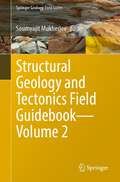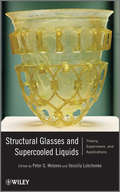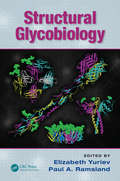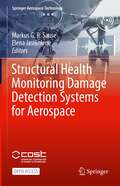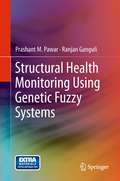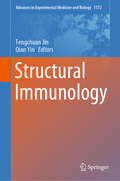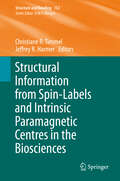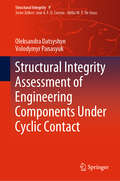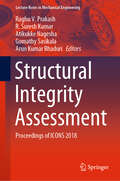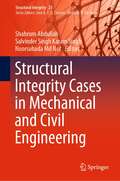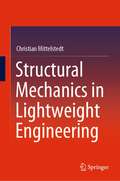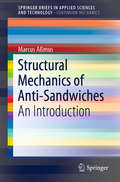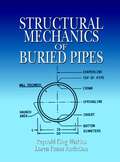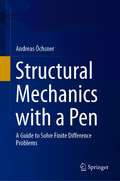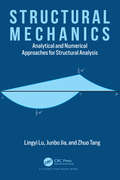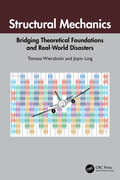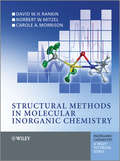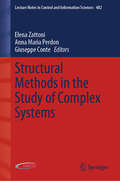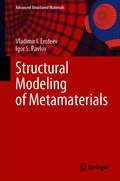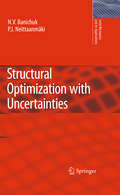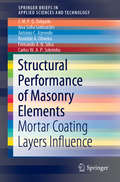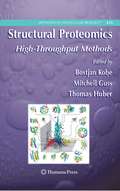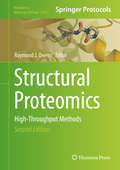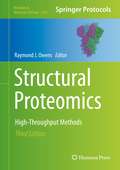- Table View
- List View
Structural Geology and Tectonics Field Guidebook—Volume 2 (Springer Geology)
by Soumyajit MukherjeeThis book is the second volume of an edited work aiming to help novice geologists to explore terrains independently. Geoscience fieldwork with focus on structural geology and tectonics has become more important in the last few years from both academic and industrial perspectives. This book also works as a resource material for batches of students or geological survey professionals undergoing training as parts of their course curriculum/training. Industry persons, on the other hand, can get a first-hand idea about what to expect in the field, in case no academic persons are available with the team. This book focuses on structural geology and tectonics and compiles terrains from several regions of the globe. This book also includes field guide chapters for primary sedimentary structures.
Structural Glasses and Supercooled Liquids
by Vassiliy Lubchenko Peter G. WolynesWith contributions from 24 global experts in diverse fields, and edited by world-recognized leaders in physical chemistry, chemical physics and biophysics, Structural Glasses and Supercooled Liquids: Theory, Experiment, and Applications presents a modern, complete survey of glassy phenomena in many systems based on firmly established characteristics of the underlying molecular motions as deduced by first principle theoretical calculations, or with direct/single-molecule experimental techniques. A well-rounded view of a variety of disordered systems where cooperative phenomena, which are epitomized by supercooled liquids, take place is provided. These systems include structural glasses and supercooled liquids, polymers, complex liquids, protein conformational dynamics, and strongly interacting electron systems with quenched/self-generated disorder.Detailed calculations and reasoned arguments closely corresponding with experimental data are included, making the book accessible to an educated non-expert reader.
Structural Glycobiology
by Elizabeth Yuriev Paul A. RamslandStructural Glycobiology covers the experimental, theoretical, and alternative technologies used in the study of the structural basis for the diverse biological roles of carbohydrates. The book overviews the application of specialized technologies to the study of carbohydrates in biology, reviews relevant and current research in the field, and is il
Structural Health Monitoring Damage Detection Systems for Aerospace (Springer Aerospace Technology)
by Markus G. R. Sause Elena JasiūnienėThis open access book presents established methods of structural health monitoring (SHM) and discusses their technological merit in the current aerospace environment. While the aerospace industry aims for weight reduction to improve fuel efficiency, reduce environmental impact, and to decrease maintenance time and operating costs, aircraft structures are often designed and built heavier than required in order to accommodate unpredictable failure. A way to overcome this approach is the use of SHM systems to detect the presence of defects. This book covers all major contemporary aerospace-relevant SHM methods, from the basics of each method to the various defect types that SHM is required to detect to discussion of signal processing developments alongside considerations of aerospace safety requirements. It will be of interest to professionals in industry and academic researchers alike, as well as engineering students.This article/publication is based upon work from COST Action CA18203 (ODIN - http://odin-cost.com/), supported by COST (European Cooperation in Science and Technology). COST (European Cooperation in Science and Technology) is a funding agency for research and innovation networks. Our Actions help connect research initiatives across Europe and enable scientists to grow their ideas by sharing them with their peers. This boosts their research, career and innovation.
Structural Health Monitoring Using Genetic Fuzzy Systems
by Prashant M. Pawar Ranjan GanguliStructural health monitoring (SHM) has emerged as a prominent research area in recent years owing to increasing concerns about structural safety, and the need to monitor and extend the lives of existing structures. Structural Health Monitoring Using Genetic Fuzzy Systems elaborates the process of intelligent SHM development and implementation using the evolutionary system. The use of a genetic algorithm automates the development of the fuzzy system, and makes the method easy to use for problems involving a large number of measurements, damage locations and sizes; such problems being typical of SHM. The ideas behind fuzzy logic, genetic algorithms and genetic fuzzy systems are also explained. The functionality of the genetic fuzzy system architecture is elucidated within a case-study framework, covering: * SHM of beams; * SHM of composite tubes; and * SHM of helicopter rotor blades. Structural Health Monitoring Using Genetic Fuzzy Systems will be useful for aerospace, civil and mechanical engineers working with structures and structured components. It will also be useful for computer scientists and applied mathematicians interested in the application of genetic fuzzy systems to engineering problems.
Structural Immunology (Advances in Experimental Medicine and Biology #1172)
by Tengchuan Jin Qian YinThis book presents a comprehensive overview of important immune molecules and their structure-function relationships. The immune system is highly complex, consisting of a network of molecules, cells, tissues and organs, and the immune reaction is involved in various physiological as well as pathological processes, including development, self-tolerance, infection, immunity, and cancer. Numerous molecules participate in immune recognition, inhibition and activation, and these important immune molecules can be roughly divided into cell surface receptors, intracellular receptors and intracellular signaling molecules. The study of how these immune molecules function at molecular level has laid the foundation for understanding the immune system. The book provides researchers and students with the latest research advances concerning the structural biology of key immune molecules/pathways, and offers immunologists essential insights into how these immune molecules function.
Structural Impact
by Norman JonesStructural Impact is concerned with the behaviour of structures and components subjected to large dynamic, impact and explosive loads which produce inelastic deformations and is of interest for safety calculations, hazard assessments and energy absorbing systems throughout industry. The first five chapters of this book introduce the rigid plastic methods of analysis for the static behaviour and the dynamic response of beams, plates and shells. These chapters develop the key features of the subject from an engineering viewpoint, and are followed by several chapters on various phenomena of importance to structural impact. The influence of transverse shear, rotatory inertia, finite displacements and dynamic material properties are introduced and studied in some detail. Dynamic progressive buckling, which develops in several energy absorbing systems, is then examined, while the phenomenon of dynamic plastic buckling is introduced in the penultimate chapter. The last chapter on the scaling laws is important for relating the response of small-scale experimental tests to the dynamic behaviour of full-scale prototypes. This text is invaluable to undergraduates, graduates, and professionals who want to learn more about the behaviour of structures subjected to large impact, dynamic and blast loadings producing an inelastic response.
Structural Information from Spin-Labels and Intrinsic Paramagnetic Centres in the Biosciences
by Christiane R. Timmel Jeffrey R. HarmerPulse Dipolar Electron Spin Resonance: Distance Measurements by Peter P. Borbat, Jack H. Freed. Interpretation of Dipolar EPR Data in Terms of Protein Structure, by Gunnar Jeschke. Site-Directed Nitroxide Spin Labeling of Biopolymers, by Sandip A. Shelke and Snorri Th. Sigurdsson. Metal-Based Spin Labeling for Distance Determination, by Daniella Goldfarb. Structural Information from Spin-Labelled Membrane-Bound Proteins, by Johann P. KLare, Heinz-Jürgen Steinhoff. Structural Information from Oligonucleotides, by Richard Ward and Olav Schiemann. Orientation selective DEER using rigid spin labels, cofactors, metals, and clusters, by Claudia E. Tait, Alice M. Bowen, Christiane R. Timmel, Jeffrey Harmer
Structural Integrity Assessment of Engineering Components Under Cyclic Contact (Structural Integrity #9)
by Oleksandra Datsyshyn Volodymyr PanasyukThis book focuses on surface layers fracture of cyclical contacting bodies (machine parts). Calculation models and calculating procedures of stress-strain states of cyclically contacting solids with cracks, are included. Recommendations for the optimization of operating parameters of joints (contact stresses magnitude, friction/lubrication conditions, materials crack resistance etc) for elements of rolling pairs (wheel–rail systems, backup roll – working roll of rolling mills etc.) and some fretting pairs are formulated.
Structural Integrity Assessment: Proceedings of ICONS 2018 (Lecture Notes in Mechanical Engineering)
by Raghu V. Prakash R. Suresh Kumar Atikukke Nagesha Gomathy Sasikala Arun Kumar BhaduriThis volume contains selected papers from the Second Quadrennial International Conference on Structural Integrity (ICONS-2018). The papers cover important topics related to structural integrity of critical installations, such as power plants, aircrafts, spacecrafts, defense and civilian components. The focus is on assuring safety of operations with high levels of reliability and structural integrity. This volume will be of interest to plant operators working with safety critical equipment, engineering solution providers, software professionals working on engineering analysis, as well as academics working in the area.
Structural Integrity Cases in Mechanical and Civil Engineering (Structural Integrity #23)
by Shahrum Abdullah Salvinder Singh Karam Singh Noorsuhada Md NorThis book covers most of the damage mechanism in the scope of mechanical engineering and civil engineering. The failure pattern of various materials and structures is mainly discussed. The sub-topics covers fatigue damage, fatigue crack initiation and propagation, life prediction techniques, computational fracture mechanics, dynamic fracture, damage mechanics and assessment, non-destructive test (NDT), concrete failure assessment, failure on soil structures, structural durability and reliability, structural health monitoring, construction damage recovery, and any relevant topics related to failure analysis.
Structural Mechanics in Lightweight Engineering
by Christian MittelstedtThis book provides a comprehensive yet concise presentation of the analysis methods of lightweight engineering in the context of the statics of beam structures and is divided into four sections. Starting from very general remarks on the fundamentals of elasticity theory, the first section also addresses plane problems as well as strength criteria of isotropic materials. The second section is devoted to the analytical treatment of the statics of beam structures, addressing beams under bending, shear and torsion. The third section deals with the work and energy methods in lightweight construction, spanning classical methods and modern computational methods such as the finite element method. Finally, the fourth section addresses more advanced beam models, discussing hybrid structures as well as laminated and sandwich beams, in addition to shear field beams and shear deformable beams. This book is intended for students at technical colleges and universities, as well as for engineers in practice and researchers in engineering.
Structural Mechanics of Anti-Sandwiches
by Marcus AßmusThis book provides an extensive introduction to the mechanics of anti-sandwiches: non-classical composites with multiple homogeneous layers but widely differing parameters concerning their geometry and materials. Therefore, they require special attention in the context of structural mechanics. The theoretical framework presented here is based on a five parametric, planar continuum, which is a pragmatic version of the COSSERAT shell. The direct approach used here is enlarged where constraints are introduced to couple layers and furnish a layer-wise theory. Restrictions are made in terms of linearity – geometrical and physical. After having defined appropriate variables for the kinematics and kinetics, linear elastic material behaviour is considered, where the constitutive tensors are introduced in the context of isotropy. The basics are presented in a clear and distinct manner using index-free tensor notation. This format is simple, concise, and practical. Closed-form solutions of such boundary value problems are usually associated with serious limitations on the boundary conditions, which constitutes a serious disadvantage. To construct approximate solutions, a variational method is employed as the basis for computational procedures where the Finite Element Method is applied. Therefore, the introduction of the vector-matrix notation is convenient. Based on the plane considerations, a finite eight-node SERENDIPITY element with enlarged degrees of freedom is realised. To avoid artificial stiffening effects, various integration types are applied, and the solutions generated are subsequently verified with closed-form solutions for monolithic limiting cases. Within this setting, it is possible to efficiently calculate the global structural behaviour of Anti-Sandwiches, at least up to a certain degree. The power of the proposed method in combination with the numerical solution approach is demonstrated for several case and parameter studies. In this regard, the optimal geometrical and material parameters to increase stiffness are analysed and the results for the kinematic and kinetic quantities are discussed.
Structural Mechanics of Buried Pipes
by Reynold King Watkins Loren Runar AndersonBuried pipes are a highly efficient method of transport. In fact, only open channels are less costly to construct. However, the structural mechanics of buried pipes can be complicated, and imprecisions in the properties of the soil envelope are usually too great to justify lengthy, complicated analyses. Designers and engineers need principles and m
Structural Mechanics with a Pen: A Guide to Solve Finite Difference Problems
by Andreas ÖchsnerThis book is focused on the introduction of the finite difference method based on the classical one-dimensional structural members, i.e., rods/bars and beams. It is the goal to provide a first introduction to the manifold aspects of the finite difference method and to enable the reader to get a methodical understanding of important subject areas in structural mechanics. The reader learns to understand the assumptions and derivations of different structural members. Furthermore, she/he learns to critically evaluate possibilities and limitations of the finite difference method. Additional comprehensive mathematical descriptions, which solely result from advanced illustrations for two- or three-dimensional problems, are omitted. Hence, the mathematical description largely remains simple and clear.
Structural Mechanics: Analytical and Numerical Approaches for Structural Analysis
by Junbo Jia Lingyi Lu Zhuo TangThis book covers both standard and advanced topics of structural mechanics. Standard subjects covered include geometric stability, forces and displacements of statically determinate structures, force and displacement method, and influence lines. Advanced topics include matrix displacement method, dynamics of structures, and limit loading. The book serves both as a classroom textbook and as a permanent engineering reference. It is written in such a way that it can be followed by anyone with a basic knowledge of classical and material mechanics.
Structural Mechanics: Bridging Theoretical Foundations and Real-World Disasters
by Tomasz Wierzbicki Jiayin LingStructural Mechanics covers three different aspects of modern engineering: the foundation of structural mechanics, the solution to urgent industrial problems, and the reconstruction of major accidents. This book offers six case studies that teach how to identify the most important phase of the collapse or fracture of a complex system, develop a simple mathematically tractable model, and offer a discussion of the analytical and numerical solutions. This book originated from the lecture notes of Professor Tomasz Wierzbicki who taught at MIT and Stanford University. The notes were amended and improved many times over the years to provide a link between rigorous theoretical foundations with solutions to important engineering problems. The book discusses complex man-made structures under accidental impact or explosive loads, resulting in the loss of life and/or extensive property, infrastructural, and environmental damage. The book deals with reconstructing the sequence of events of such accidents from the structural point of view. The book is not restricted to the accident reconstruction only - concepts and solutions of the elasticity, advance plasticity and ductile fracture were used throughout the reconstruction of the accidents. The additional 17 lectures provide theoretical foundations for the elastic structures, plastic plates and shells, and ductile fracture. Not only is this an essential textbook for graduate students studying structural mechanics, it is also relevant to industry professionals, researchers, and academics in the field of engineering.
Structural Methods in Molecular Inorganic Chemistry
by Carole Morrison D. W. Rankin Norbert MitzelDetermining the structure of molecules is a fundamental skill that all chemists must learn. Structural Methods in Molecular Inorganic Chemistry is designed to help readers interpret experimental data, understand the material published in modern journals of inorganic chemistry, and make decisions about what techniques will be the most useful in solving particular structural problems.Following a general introduction to the tools and concepts in structural chemistry, the following topics are covered in detail:* computational chemistry* nuclear magnetic resonance spectroscopy * electron paramagnetic resonance spectroscopy * Mössbauer spectroscopy * rotational spectra and rotational structure * vibrational spectroscopy * electronic characterization techniques* diffraction methods * mass spectrometryThe final chapter presents a series of case histories, illustrating how chemists have applied a broad range of structural techniques to interpret and understand chemical systems.Throughout the textbook a strong connection is made between theoretical topics and the real world of practicing chemists. Each chapter concludes with problems and discussion questions, and a supporting website contains additional advanced material.Structural Methods in Molecular Inorganic Chemistry is an extensive update and sequel to the successful textbook Structural Methods in Inorganic Chemistry by Ebsworth, Rankin and Cradock. It is essential reading for all advanced students of chemistry, and a handy reference source for the professional chemist.
Structural Methods in the Study of Complex Systems (Lecture Notes in Control and Information Sciences #482)
by Elena Zattoni Anna Maria Perdon Giuseppe ConteStructural Methods in the Study of Complex Systems helps the reader respond to the challenge of mastering complexity in systems and control. The book details the fundamental control problems arising from complex dynamical systems and shows how they can be tackled effectively by means of methods developed from graph theory, differential algebra and geometric approaches. These “structural methods” produce abstractions that fit a wide variety of applications by taking advantage of their intrinsic focus on the essential characteristics of dynamical systems, their geometric perspective and visual representation, and their algebraic formalization and ability to generate algorithmic frameworks to complement the theoretical treatment. The original work and latest achievements of the contributors, expanding on material presented at a workshop organized to coincide with the 2018 European Control Conference will assist systems and control scientists interested in developing theoretical and computational tools to solve analysis and synthesis problems involving complex dynamical systems. The contributions provide a comprehensive picture of available results along with a stimulating view of possible directions for future investigations in the field. Emphasis is placed on methods with solid computational background and on specific engineering applications so that readers from both theoretical and practical backgrounds will find this collection of use.
Structural Modeling of Metamaterials (Advanced Structured Materials #144)
by Igor S. Pavlov Vladimir I. ErofeevThis book discusses the theoretical foundations of the structural modeling method applied to metamaterials. This method takes into account the parameters of the crystal lattice, the size of the medium particles, as well as their shape and constants of force interactions between them. It provides mathematical models of metamaterials that offer insights into the qualitative influence of the local structure on the effective elastic moduli of the considered medium and into performing theoretical estimations of these quantities. This book is useful for researchers working in the fields of solid mechanics, physical acoustics, and condensed matter physics, as well as for graduate and postgraduate students studying mathematical modeling methods.
Structural Optimization with Uncertainties
by Pekka Neittaanmäki N. V. BanichukThis monograph is devoted to the exposition of new ways of formulating problems of structural optimization with incomplete information and techniques of solution. Research results concerning the optimum shape and structural properties of the bodies subjected to external loadings are recapitulated. Problems of optimal design with incomplete information, accounting for the interaction between the structure and its environment, properties of materials, existence of initial damages and damage accumulation are studied. This volume treats overcoming the corresponding mathematical difficulties caused by raising local functionals. Most of the book is devoted to the minimax approach using worst case scenarios, i.e. the so-called guaranteed approach. However, the probabilistic approach, that does not guarantee the result, is also described in the monograph, because it gives more "optimistic" results. Also, the mixed probabilistic guaranteed approach is discussed and applied for the solution of structural optimization problems with uncertainties.
Structural Performance of Masonry Elements: Mortar Coating Layers Influence (SpringerBriefs in Applied Sciences and Technology)
by Ana Sofia Guimarães António C. Azevedo Romilde A. Oliveira J. M. Delgado Fernando A.N. Silva Carlos W.A.P. SobrinhoThis book discusses the main mechanical features of masonry buildings and the peculiarities that affect their structural behaviour. It also examines technical information regarding accidents that have occurred in recent years in the Metropolitan Region of Recife, along with the historical records of these events, followed by indications of the causes for the collapse. The book offers extensive experimental results that make it possible to identify the contribution of several mortar rendering layers to the load capacity of the tested specimens. Lastly, it explores the factors that influenced the load capacity of the tested specimens.
Structural Proteomics
by Mitchell Guss Bostjan Kobe Thomas HuberThe objective of this volume is to provide readers with a current view of all aspects of the 'pipeline' that takes protein targets to structures and how these have been optimised. This volume includes chapters describing, in-depth, the individual steps in the Structural Genomics pipeline, as well as less detailed overviews of individual Structural Genomics initiatives. It is the first book of protocols to cover techniques in a new and emerging field.
Structural Proteomics
by Raymond J. OwensThis updated and expanded volume reflects the current state of the structural protein field with improved and refined protocols that have been applied to particularly challenging proteins, notably integral membrane proteins and multi-protein complexes. Structural Proteomics: High-Throughput Methods, Second Edition begins by exploring the resources available for curation, annotation, and structure prediction in silico, and continues with methods for sample preparation of both proteins and crystals, as well as structural characterization techniques. Written for the highly successful Methods in Molecular Biology series, chapters include introductions to their respective topics, lists of the necessary materials and reagents, step-by-step, readily reproducible laboratory protocols, and tips on troubleshooting and avoiding known pitfalls. Practical and up-to-date, Structural Proteomics: High-Throughput Methods, Second Edition will aid researchers in expanding our knowledge of this vital and expansive area of protein science.
Structural Proteomics: High-Throughput Methods (Methods in Molecular Biology #2305)
by Raymond J. OwensThis updated and expanded volume reflects the current state of the structural protein field with improved and refined protocols that have been applied to particularly challenging proteins. Beginning with a section on structural bioinformatics, the book continues with sections covering the challenge of producing high quality samples for structural studies, particularly mammalian membrane proteins and protein complexes, as well as protocols for structure determination, including the use of electrons in structural biology and more. Written for the highly successful Methods in Molecular Biology series, chapters include introductions to their respective topics, lists of the necessary materials and reagents, step-by-step, readily reproducible laboratory protocols, and tips on troubleshooting and avoiding known pitfalls. Authoritative and up-to-date, Structural Proteomics: High-Throughput Methods, Third Edition will aid researchers in expanding our knowledge of this vital and expansive area of protein science.Chapter 9 is available open access under a CC BY 4.0 license.
